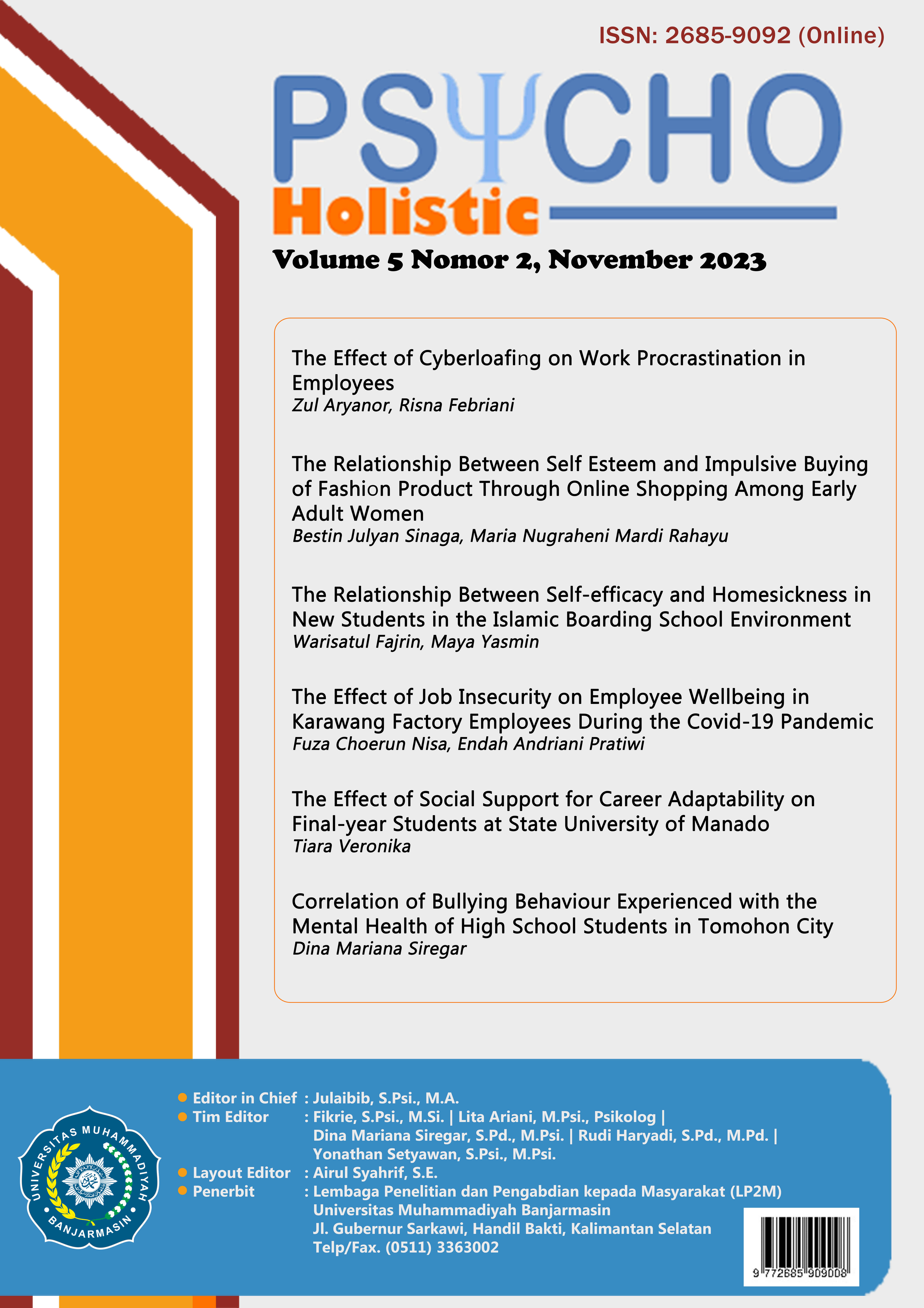The Relationship Between Self-efficacy and Homesickness in New Students in the Islamic Boarding School Environment
DOI:
https://doi.org/10.35747/ph.v5i2.753Keywords:
homesickness, Islamic boarding school, new students, self-efficacyAbstract
This study aims to determine the relationship between self-efficacy and homesickness in new students at Islamic boarding schools. This research is quantitative research with correlation data analysis of Product Moment. This research involved 322 new Islamic boarding school students in Agam Regency, West Sumatra using cluster random sampling technique. The scales used in this study are the General Self-efficacy Scale (GSES) belonging to Schwarzer (1995) and the homesickness scale which was self-compiled based on the theory of Stroebe et al. (2002). The results showed that there is a negative relationship between self-efficacy and homesickness in new students at Islamic boarding schools. So, to reduce homesickness in new students at Islamic boarding school, it is necessary to have a role of self-efficacy in new students.
References
Alwisol. (2004). Psikologi kepribadian. UMM Press.
Arefi, M., & Jan, R. G. S. (2016). Relationship between homesickness, self-efficacy, and achievement motivation among non-native students of Urmia University of Medical Sciences. IICEDubai2016 Conference Proceedings. https://papers.iafor.org/submission22844/
Bandura, A., & Adams, N. E. (1977). Analysis of self-efficacy theory of behavioral change. Cognitive Therapy and Research, 1(4), 287–310. https://doi.org/10.1007/BF01663995
D’Lima, G. M., Winsler, A., & Kitsantas, A. (2014). Ethnic and gender differences in first-year college students’ goal orientation, Self-Efficacy, and extrinsic and intrinsic motivation. Journal of Educational Research, 107(5), 341–356. https://doi.org/10.1080/00220671.2013.823366
English, T., Davis, J., Wei, M., & Gross, J. J. (2017). Homesickness and adjustment across the first year of college: A longitudinal study. Emotion, 17(1), 1–5. https://doi.org/10.1037/emo0000235
Ghozali, I. (2016). Aplikasi analisis multivariate dengan program IBM SPSS 23 (8th ed.). Badan Penerbit Universitas Diponegoro.
Komariah, N. (2016). Pondok pesantren sebagai role model pendidikan bersistem full day school. Hikmah: Jurnal Pendidikan Islam, 5(2), 183–198. https://doi.org/10.55403/hikmah.v5i2.30
Lianto. (2019). Self-efficacy: A brief literature review. Jurnal Manajemen Motivasi, 15(2), 55–61. https://doi.org/10.29406/jmm.v15i2.1409
Maryam, S. (2015). Self efficacy anak didik pemasyarakatan di Lapas anak kelas IIA Blitar [Universitas Islam Negeri Maulana Malik Ibrahim Malang]. http://etheses.uin-malang.ac.id/1236/
Schwarzer, R., & Jerusalem, M. (1995). Generalized self-efficacy scale. In J. Weinman, S. Wright, & M. Johnston (Eds.), Measures in health psychology: A user’s portfolio. Causal and control beliefs (pp. 35–37). NFER-NELSON.
Shal, R. S., Sharbaf, H. A., Abdekhodaee, M. S., Masoleh, S. M. K., & Salehi, I. (2011). Survey the relationship between attachment style and general self efficacy with homesickness among college students. Procedia - Social and Behavioral Sciences, 30, 538–541. https://doi.org/10.1016/j.sbspro.2011.10.105
Shasra, S. F. (2022). Gambaran homesickness siswa baru di pondok pesantren. Nusantara: Jurnal Ilmu Pengetahuan Sosial, 9(4), 1247–1252. https://doi.org/10.31604/JIPS.V9I4.2022.1247-1252
Singh, Bhardwaj, T. D., & Bhardwaj, G. (2009). Effect of self-efficacy on the performance of athletes. Journal of Exercise Science and Physiotherapy, 5(2), 110–114. http://www.efha.in/wp-content/uploads/2015/01/JESP-5-110.pdf
Smith, G. (2007). Effects of self-efficacy and self-esteem on homesickness and college adjustment. https://eric.ed.gov/?id=ED497507
Stroebe, M., Van Vliet, T., Hewstone, M., & Willis, H. (2002). Homesickness among students in two cultures: Antecedents and consequences. British Journal of Psychology, 93(2), 147–168. https://doi.org/10.1348/000712602162508
Sugiyono. (2021). Metode penelitian kuantitatif, kualitatif, dan R&D (3rd ed.). Alfabeta.
Utami, L. S. S. (2015). Teori-teori adaptasi antar budaya. Jurnal Komunikasi, 7(2), 180–197. https://doi.org/10.24912/JK.V7I2.17
Van Tilburg, M. A. L., Vingerhoets, A. J. J. M., & Van Heck, G. L. (1997). Coping with homesickness: The construction of the adult homesickness coping questionnaire. Personality and Individual Differences, 22(6), 901–907. https://doi.org/10.1016/S0191-8869(97)00010-X
Yasmin, M., Zulkarnain, & Daulay, D. A. (2018). Gambaran homesickness pada siswa baru di lingkungan pesantren. Psikologia: Jurnal Pemikiran dan Penelitian Psikologi, 12(3), 165–172. https://doi.org/10.32734/psikologia.v12i3.2260
Yusoff, Y. M. (2012). Self-efficacy, perceived social support, and psychological adjustment in international undergraduate students in a public higher education institution in Malaysia. Journal of Studies in International Education, 16(4), 353–371. https://doi.org/10.1177/1028315311408914
Downloads
Published
How to Cite
Issue
Section
License
Copyright (c) 2023 Warisatul Fajrin, Maya Yasmin

This work is licensed under a Creative Commons Attribution-ShareAlike 4.0 International License.














